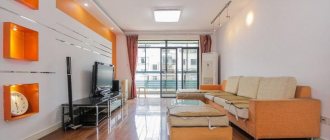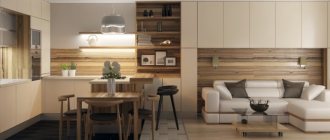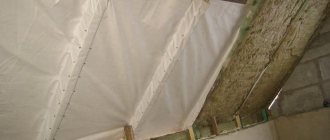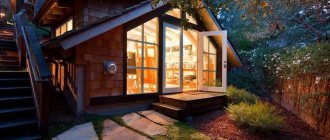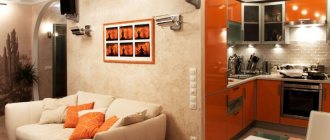Comfort in any room is largely determined by its lighting. The best source is sunlight, which can be obtained from windows. With proper glazing, the room will not only be light, but also warm and cozy.
According to SNiP, in order to ensure a minimum amount of light penetrating into the room, the glazing area is about 10–12.5% of the total. In addition to the linear dimensions of the window, their ratio is also important. For better visual perception, it is recommended to bring the width to height ratio as close as possible to the parameters of a harmonic rectangle, say, 80 to 130.
Why is it important to know the window area?
Windows are very specific designs.
On the one hand, they provide sufficient illumination of the room, on the other hand, they are the largest “black hole” through which heat escapes to the street. Both extremes are usually the result of errors in construction calculations or lack thereof.
According to construction rules, the minimum amount of light penetrates into a room in which the total area of all windows is 10–12.5% of the total area of the room.
In this case, not only the width and height of the window is important, but their ratio. The closer the proportion is to a harmonious rectangle, the better it is perceived visually and the more convenient it is to use.
A window that is close to ideal is a rectangle with the correct proportions (for example: 80 cm wide and 130 cm high).
In order to make it convenient to look outside, the upper edge of the wall under the window should be no higher than 90–100 cm. In turn, the upper edge of a convenient window is at a height of about cm from the floor and leaves enough space for attaching curtains, blinds or a roller shutter.
The decision is up to the owners
The Moscow overhaul program is distinguished by an integrated approach: if a house is included in it, all utility systems are repaired in order to completely restore it. The list of types of work in the capital is longer than that established by the Housing Code of the Russian Federation. It includes 15 points: this is the repair of water supply, heating, sewerage, gas supply, electrical systems, elevators, basements, facades, roofs and foundations. In addition, fire protection systems, fire water pipes and internal drains are being updated in high-rise buildings, garbage chutes and windows in common areas are being replaced, and entrances are being repaired.
What exactly needs to be done from this list is decided by the apartment owners at a general meeting. We try to take into account all their suggestions. The main condition is that the work must be included in the accepted list. In addition, residents of the house can independently choose the design of the elements and colors of the future decoration of the entrances of the house; several color schemes have been developed for this.
“Residents are offered options for color combinations of materials for finishing the entrance. The catalog has options for every taste: from beige to green, from soft gray to brown. In general, we were able to understand the preferences of most people; 90 percent of residents choose design solutions. But if they don't like something, they can offer their own colors. The opinion of residents is the law,” said Evgeniy Chuishchev, head of the production technical department of the Capital Repair Fund.
If the meeting can be held quickly, the house can even be repaired ahead of schedule: if there is a decision from the owners, houses that are inextricably linked by their utility networks or structures with those that were previously included in the program are repaired earlier.
Design and estimate documentation is developed for each house, which undergoes state examination.
How to calculate the approximate size of a window in an apartment or house
Even at the design stage, all parameters of optimal glazing for each specific room are determined. The calculations are quite complex for a non-specialist, so let’s consider their results for one living room at an angle of incidence of daylight from 18 to 30 degrees.
For comfortable lighting, the ratio of the glass area to the floor area of this room should be from 1/8 to 1/5. This means that the window will occupy an area of 14–17% of the floor area.
As for the height of the window sill, it is determined by the purpose of the room:
- in living rooms - from 70 to 90 cm;
- in work areas - from 90 to 100 cm;
- in the kitchen - 125 cm;
- in bathrooms and utility rooms - from 130 to 150 cm;
- in dressing rooms - 175 cm.
How experts calculate glazing area
From the point of view of designers, windows are the most vulnerable points in the building envelope. Through them there is intense energy exchange between the room and the environment.
Calculation of window area is carried out according to the methods given in SNiP (“Building Norms and Rules”). They provide illumination standards for various types of premises, corresponding coefficients and formulas.
In a simplified way, the area of light openings can be calculated based on the recommended ratios between the areas of windows and floors. These data were not taken out of thin air, but were obtained on the basis of many years of data analysis in various regions of the world.
The relevant information was summarized and compiled into easy-to-use tables.
For example, for civil buildings in the climatic conditions of the middle zone at an altitude not higher than 800 m above sea level, with slight shading by nearby buildings, the ratio of glazing area to floor area will be as follows:
- living rooms - 1/8–1/6;
- kitchens and corridors - 1/10–1/8;
- staircases - 1/14–1/10;
- classes and audiences - 1/4–1/3;
- playing and dining rooms in kindergartens - 1/4–1/3;
- hotel rooms - 1/8–1/6;
- library reading rooms - 1/6–1/5;
- offices and laboratories of the research institute - 1/7–1/5;
- administrative premises - 1/10–1/6;
- sports gymnasiums - 1/6–1/5;
- gyms - 1/5–1/4;
- medical offices - 1/7–1/5;
- hospital wards - 1/7–1/6;
- restaurant halls - 1/8–1/6;
- trading floors of stores - 1/8–1/6.
Clarifying calculation
However, these are not the only guidelines for calculating window sizes. There are other quite working methods for determining the area of light openings using special formulas, in which one of the most important parameters is also the floor area.
Today, different countries use several different methods for calculating the KEO (daylight coefficient):
- protractor method
- grid method
- ray method
- luminous flux utilization factor method
- analytical methods
They all give similar results.
How to calculate the area of windows so that the house is not dark
When designing and constructing a residential building, you must be guided by the contents of SanPiN 2.1.2.2645-10. According to this regulatory act, all residential premises are required to have light openings in the external walls of the building. The number of windows in living rooms and kitchens must be such that the coefficient of natural light is not lower than 0.5. Insolation standards are established by regulatory documentation taking into account:
- geographical latitude of the object's location;
- calendar period;
- functionality of the premises;
- planning zone of the city.
At least one of the rooms of a 1-3 room apartment must have a level of illumination that meets established standards. When the apartment consists of more than 4 rooms, then satisfactory lighting should be in 2 or more rooms.
Based on building rules, you can calculate the square footage of windows for each room in a residential building:
- Measure the floor area of each individual room.
- Determine the minimum permissible glazing area, calculating 10 - 12.5% of the resulting floor area of the room.
When designing light architectural elements, it is necessary to take into account that the final footage of the glazing will be less than the opening left. This is explained by the presence of a light-proof box at any window, which is used to install the window and fasten the glass inside the window block.
It is generally accepted that the most comfortable for a person’s well-being is the total width of the windows of the room, which is 55% of the width of the room. If there is only one window opening, then it should be located in the center of the longest outer wall.
The level of insolation can be adjusted by placing the structural element vertically: the higher the opening relative to the floor, the greater the illumination. This condition is true when there are no tall buildings or trees in the immediate vicinity that impede the penetration of sunlight.
At the design stage, when calculating the glazing surface, it is necessary to focus on the rules for thermal protection of buildings. According to these rules, the glazing coefficient of the facade in a residential building does not exceed 18%, taking into account the heat transfer resistance of light and ventilation openings.
It is permissible to install skylights in private residential buildings, which are windows of complex and non-standard geometric shapes. The area of such light openings should not exceed 15% of the floor area. In the case where the skylight is mounted in an attic room, the glazing area can be maximum equal to 10% of the room's area.
New publications are published daily on our Yandex.Zen channel
Heat preservation
As a matter of fact, SNiP controls not so much the glazing area as the level of thermal insulation of the house.
And if the owner of the building is able to maintain the required temperature inside, then, of course, the entire façade can be made glass. However, such cases are extremely rare.
According to SNiP, the temperature of the glass on the inside should be above +3 C. The temperature of the frame and window sill must be no less than the dew point. The latter is calculated in accordance with climatic conditions.
Let's look at the same room again, this time with a real view of the local computer user. His vision is focused on the monitor, but he perceives both the surroundings of the computer and his peripheral vision and surrounding space. The field of vision of the human eye can be divided into three zones: very close, close and peripheral. In the closest zone we are interested in our attention, in which we are concentrated. The proximal zone is defined by a 30° cone. Peripheral vision then takes in everything inside the cone with an upper 90° angle.
- with a heat transfer resistance of the glass structure of 0.51 square meters. m. C/W, if the heating season lasts 3500 degrees-day;
- with a resistance of 0.56 square meters. m. C/W, if you have to heat up to 5200;
- and with a resistance of 0.81 square meters. m. C/W, if the heating season extends to 7000 degrees-day.
Failure to comply with this condition results in cold, chilled rooms in winter or large excess consumption of fuel.
In an unshaded room, this recommendation cannot be implemented, as the image illustrates. The shading function is optimal if the installation of shadow elements is considered from the very beginning of the design. It can then be shaded not only as a technical device of a certain design, but also as an architectural element. Complementary decisions make tradeoffs in one direction rather than another.
An important part of making decisions about using a shading technique is considering how the technique will be monitored and controlled. Efficient use is ensured by motor devices controlled by electronic control systems. Depending on the type and type of devices being controlled and how they are controlled, design documentation for the distribution of heavy and low voltage equipment can be prepared in advance and ensure their design is timely and substantially correct.
Sizes of window openings and room illumination
In frame buildings with strip-cut walls and strip lighting, the width of window openings determines the width of individual inserts along the axes of the supporting structure of the frame.
When designing buildings, the dimensions of window openings are set taking into account the required illumination of the premises, depending on their purpose, size, natural light in specific geographical conditions, the light characteristics of the window for a given ratio of the dimensions of the room and the window opening, the light transmittance of the window block, etc.
The area of window openings as a percentage of the area of the room is regulated by the “Building Norms and Rules” (SNiP P-A862) and is determined by the formula. SNiP P-A862 gives the normalized value of k.e.o. in the main premises of residential and public buildings located north of 45° and south of 60° northern latitude, taking into account the mandatory regular cleaning of glass at least 2 times a year for rooms with insignificant emissions of dust, smoke and soot, and four times for rooms with significant emissions.
Rectangular premises
To get started, you will need a measuring tape and a calculator.
The most common option is a rectangular room; even a schoolchild knows the formula for finding its square:
S = a* b (length times width)
For example, a room with parameters 4*6 m has an area of 24 sq. m.
It's another matter if you have built-in furniture or a fireplace. If you do not plan to remove them during the renovation, and lay the flooring of an apartment or private house around them, then it is also worth calculating their sizes and subtracting them from the total value .
However, this option is only suitable for “cosmetic repairs” of the surface; if you screed the floor of an apartment or your house or install new joists, you will definitely have to dismantle everything.
What is a square meter
First you need to decide what a square meter is. People who did not study mathematics well at school still sooner or later face the problem of counting the amount of building materials. Therefore, a square meter is the main reference point when determining the area of a room.
If you draw a square (this is a geometric figure with equal sides), and the side is equal to 100 cm, then when multiplied by 100 we get the number 10000 cm. This means that the size of this figure is 10000 cm2. It could be simpler. Calculate in meters: 100 cm is 1 m. We apply the formula for calculating the area - we multiply the two sides, that is, we multiply 1 by 1, we get 1 m. This means that the size of the square is 1 sq.m.
Irregularly shaped rooms
It will be much more difficult to calculate a polygonal room with your own hands. Often the layout of houses has niches, rounded elements, and triangular corners.
Technical passport of the apartment
Calculating the floor area in such cases requires first dividing it into simpler elements. For example, you have an L-shaped room - the easiest way is to divide it into 2 rectangles, calculate their sizes separately and add them up.
L-shaped room plan
Calculate the sizes of triangular elements
If the second part of the room is not located at a perpendicular angle with respect to the main part, then between the 2 rectangles there is also a triangle, the sides of which converge at right angles.
You need to additionally calculate its quadrature using the formula and add it to the total value:
For example, if a triangle has legs of 3.5 and 4.5 m: S = (3.5*4.5)/2 = 7.9 m².
Another example of how to calculate the floor area of a room with a sloping corner is shown in the photo with all dimensions.
Scheme of a bathroom with a beveled corner
To calculate the quadrature of such a room, you need to first calculate the quadrature of the rectangle, and then for the triangle, and subtract its dimensions from the total value.
Here is an example of a calculation based on the values specified in the diagram:
- Rectangle = 2.5 * 1.75 = 4.4 m2.
- Beveled triangular corner = (0.57*0.57)/2 = 0.2 m2.
- Final size = 4.4 – 0.2 = 4.2 m2.
If the triangle is not right-angled, then its calculation is done using Heron’s formula:
Heron's formula for a triangle
The symbol "p" is semi-perimeter. For example: we have a triangular shaped floor whose sides are 5, 6 and 7 meters.
Let's do the calculation for this figure:
- Find the semi-perimeter: (5+6+7)/2 = 9.
- We substitute the values into the formula: √(9 * (9-5) * (9-6) * (9-7)) = √(9 * 4 * 3 * 2) = √216 = 14.7 m2.
Calculation of rounded elements
Often, old houses have such a rounded shape near a window, or on a balcony combined with a room.
All formulas for calculating plane figures
To do this, first calculate half of the protruding part of the circle and add it to the main rectangular part.
Formula for calculation:
S = πR 2 /2, where π – 3.14, R 2 – radius of the circle squared.
For example, we have a semicircular protruding balcony with a radius of 1.5 m.
Let's substitute the numbers into the formula and find its quadrature:
S = 3.14 * 1.5 2 / 2 = 3.5 sq. m.
Formula for calculating square meters
To calculate the area, you need to apply the formula per square meter A XB, where number A is the length of one side, and number B is the length of the second side. They can be the same if the shape of the floor or wall is square.
Most often, it is not square, but rectangular, that is, number A will have one value, and number B will have another. They will need to be multiplied in your head, or using a multiplication table, or on a calculator. And the resulting number will be the area that will need to be covered with paint or something else.
It happens that the shape of the floor is not standard, but, for example, trapezoidal. Then it’s more difficult, especially for those people who don’t know what a triangle is (this also exists in nature). To calculate the size of a trapezoid, you must first calculate the area of the rectangle in the middle, then the size of each triangle on the sides, then add these three numbers. Isn't it easier to immediately call a team of workers? Let them think about how to calculate the square meters of the room.
Wall area
Separately, it is worth noting that the area of the walls cannot be found by the area of the floor, as some people try to do. The thing is, to find the square footage of the floor you only need 2 values: width and length, and to calculate the walls you also need to know their height.
Therefore, you will first have to calculate the perimeter of the walls and multiply it by the height of the ceilings.
For example, you considered the floor dimensions to be 5*6 meters, and the room has a height of 2.5 meters.
- We calculate the perimeter of the walls: (5+6)*2 = 22 m.
- S = 22*2.5 = 55 sq. m.
Note! Don't forget to subtract the square footage of door and window openings after calculating the walls. Although they are sometimes not specifically taken into account in order to preserve the supply of materials.
Measuring tools
To correctly calculate the total quadrature you will need a tool such as:
- construction tape of at least 5 meters;
- pen or pencil;
- calculator;
- building level or similar device with a scale;
- stepladder or stool;
- a sheet of paper for notes.
Prepare everything you need to measure walls.
You can also use special services available on the Internet, however, their accuracy is not always correct, and for maximum accuracy it is better to do everything yourself.
Before calculating the area of the walls of the room, it is necessary to provide free access to them and move furniture away to allow unhindered movement
This is very important, because from the initial data obtained from the measurement, we obtain the total volume of the room, as well as the square footage of the ceiling and floor
For maximum accuracy, it is recommended that before taking measurements, mark a straight line slightly above the level of the baseboards using a building level or any other long and level strip. Next, the tape measure is applied horizontally to the surface above the baseboard and the data obtained is recorded on paper. The next step is to measure the distance from the floor to the ceiling, again leaning the tape measure against the wall.
Don't forget to write down all the data you receive.
If the room has the shape of a rectangle, then to obtain the total area of the room it is enough to multiply the resulting width by the length. For example, if a wall is 5 meters long and 3 meters wide, then multiply 5 by 3 to get 15 squares.
Similarly, we measure each wall and add the resulting values into one total. For example, in a rectangular room there are 2 walls of 15 square meters and 2 of 8, we add these values 15x2=30, 8x2=16, 30+16=46. In total, the total surface area of the walls of the room was 46 squares.
Window to floor ratio
The size and number of windows in living rooms and kitchens depend on the specific room.
- The instructions in SNiP 31-01-2003 for multi-apartment residential buildings recommend maintaining the window area to floor area in the range from 1:5.5 to 1:8. On the upper floors it is permissible to make windows with a ratio of at least 1 to 10 to the floor.
- For private houses, SNiP 31-02-2001 applies; for every 8 squares of floor there must be at least 1 square of natural light source. On attic floors this ratio can be at least 1:10.
Percentage of window openings and floor
Note! Also for residential buildings there are standards for the ratio of artificial lighting to the floor surface, described in SNiP 2.08.01-89 and 23-05-95.
For example, if your floor is 4*5 meters, the light opening should be from 2 to 3.6 square meters. To find out the glazing area to the floor area, divide the square footage of the room by a multiplier from SNiP suitable for your conditions (from 5.5 to 10). (see also the article Features of floor lighting)
Double-glazed windows: bulky or energy-saving
Of course, in a residential area, the double-glazed window must be sealed, and in our area it must also be double-glazed.
For houses whose owners are concerned about energy saving, double-glazed windows with improved thermophysical characteristics are offered - with argon filling and heat-reflecting coating (the so-called I-glass and K-glass). According to manufacturers, they can reduce heat loss by 30-40% compared to conventional ones, and in some cases, make do with a lightweight single-chamber design instead of a bulky and heavy two-chamber one. Heat-reflective coatings work, as they say, on two fronts - retaining heat in winter and preventing the room from turning into a greenhouse under direct sunlight.
One of the areas of application for improved single-chamber double-glazed windows is large glazing surfaces. But thin window glass is not an option in this case - in translucent structures, thick glass is used - from 8 mm. A square meter of such sheet glass weighs 20 kg, and the total weight of structures consisting of double-glazed windows of frame and frame profiles can be calculated in tons; their design requires precise calculations, and installation requires special equipment and highly qualified performers.
Standard window size for residential premises
In a private house
Standards for window openings exist to regulate light in private homes and beyond.
The characteristics of window openings are based on what the room is intended for, but the following is also provided:
- the ability of a window package to transmit light;
- geography;
- dimensions of the building;
- degree of suitable lighting.
- for “brezhnevka” the dimensions of a double-leaf window are 1300x1400 mm, with three sashes - 2100x1400 mm;
- for the “new layout”: with two doors 1460X1430 mm, with three - 1780X1430 mm;
- “Stalinka” is characterized by T-shaped windows, its dimensions can be 1500X1900 mm, 1250X1800 mm and 1080X1800 mm;
- for “Khrushchev”: double-leaf window 1208X1340 mm, three-leaf window - 2040X1500 mm;
- for the “Czech”: with two doors 1300X1400 mm, with three - 1760X1400 mm.
Based on building codes, we calculate window standards. In addition, they are designed for cleaning twice a year, and for areas with poor ecology - 4 times a year .
Now they also provide for the number of glasses in the package and the distance between them - for each customer the refractive index of the beam will not be calculated, and the illumination will decrease.
If we take single-leaf windows, then their usual width and height vary from 470X470 mm to 1470X870 mm. Naturally, everything here depends on the dimensions of the opening.
Let's look at double- and triple-hung windows. Windows with two sashes vary from 570X1170 mm to 1470X1470 mm. Window openings with three sashes vary from 1170X1770 mm to 1470X2070 .
Do you know how to make plastic window slopes with your own hands? Details are in this article.
In the apartment
Now let's look at the standards of windows in an apartment panel building. It all depends on the type of house:
External transformation
The overhaul program includes repairs to the facades of high-rise buildings. This is especially true for houses built in the 1960s and 1970s. At that time, it was fashionable to cover facades with fine-grained tiles, which today are actively crumbling.
Small tiles were applied to façade panels at the factory; it is impossible to completely restore or remove them. The poor condition of such a coating destroys the outer protective layer of the panels and reinforcement frame. As a result, the thermal insulation layer of the structure may become wet. Over the decades, many interpanel seams have also deteriorated. All this leads to the fact that the temperature regime in the apartments is disrupted, the walls become wet, and mold and mildew appear.
“To repair facades during major renovations, we use modern technologies that allow us not only to return the house to its original technical parameters, but also to its beautiful appearance. In recent years, the approach to repair and color has been revised very deeply. We keep up with the times, creating coziness and comfort for Muscovites. Together with the overhaul, the house essentially acquires a second life. The whole place is being transformed and updated,” said Evgeniy Chuishchev.
Now these houses are plastered with polymer-cement compositions, using reinforcing mesh and adhesive components with high bonding ability. First, the old tiles are cleaned, removing the glaze, which does not adhere well to adhesives. A primer and anti-corrosion mixture are applied on top, then a plaster-adhesive mixture and a reinforcing mesh. Interpanel seams are cleared and sealed, the joints are filled with strands of foamed polyethylene. On top you can apply decorative plaster immediately with color or cover the facade with water-dispersed acrylic paint.
Modern materials make it possible to completely restore the thermal properties of panels. And externally, after such repairs, the facade looks like new and can remain that way for 20–25 years, notes Evgeniy Chuishchev. The basalt mesh and polymer prevent the tiles from collapsing and water does not penetrate into them.
Over 660 thousand square meters of facades have already been repaired using the new technology. And since 2015, facade repairs have taken place in more than four thousand houses, where more than a million Muscovites live.
“With other houses, everything is simpler: in panel houses we paint the facade, in brick houses we wash them, clean them of dust accumulated over the years and seal them to repel moisture,” added the head of the Capital Repair Fund department.
How to choose?
You should not trust standard sizes, since they do not exist in principle - the thickness of the walls and the height of the openings in all houses are different, and accordingly, the standards are different.
It is necessary to invite a measurer who will correctly measure the measurements, that is, height and width. However, preliminary measurements can be made independently to calculate the approximate cost of the finished structure.
In rooms where residents and their guests will stay for a long period of time, the ratio of windows to room area should be 1:8.
If the window is the only one in the room, place it in the center of a long wall and higher - in this case, the light will fall evenly throughout the room and flow evenly. The upper slope should not be created too far from the ceiling.
When searching for the optimal size and shape for a window, you need to approach it wisely and take into account several features. One of these is the degree of illumination. In order to plan the dimensions of the openings well, and most importantly, correctly, the following rules should be followed:
- The most comfortable lighting for a person is the kind of lighting in which the width of the windows is at least 55% of the width of the entire room.
- According to the rules, the lowest illumination is achieved provided that the glazing area is at least 10-12.5% of the total area of the room.
The most ideal proportions are considered to be a rectangle with a width to height ratio of 80x130 cm. Such windows are easy to use and do not create unnecessary load on the fittings .
Consumer protection
It is believed that norms and standards are designed to protect consumers from low-quality housing. But is it? And does GOST cope with the functions that are assigned to it? And is such comprehensive standardization necessary? Everything that we now use to protect ourselves from cold or heat came to us from the West. A new type of profile for window systems, low-emissivity glass, blinds, roller blinds, mini-blinds. All, at first outlandish, technology and attributes of protection from the sun and cold came to us from there, without any norms and standards, GOSTs and TUs. The main standards used in these countries are convenience, quality and comfort. In Germany, France, Denmark, and England, when installing sealed PVC window systems, it is mandatory to install climate control valves. And this is enshrined in law, and not a minimum or maximum window size, which is of no interest to anyone. If the windows do not meet the clients' requirements, no one will buy a house or an apartment. And this is enough for the architectural product to always be harmonious in its decisions, including in matters of glazing. And it must be said that not everything is going smoothly with the provision of housing there either. Not everyone can afford expensive penthouses. However, standardization, which certainly exists in these countries, and is no less highly developed, still does not interfere with market issues, which determine which windows, in which region and with which energy-saving equipment should be designed. And the standards they use are much broader and more comprehensive. Moreover, they are international and equally understandable in Australia, Singapore, and Japan. and Germany. But they relate to completely different areas of engineering and technology, which provide the priorities of international trade.
Standards according to GOST
For window opening standards, there is a State Standard regulation numbered 11214-86. This standard also determines the dimensions for balcony doors. In accordance with this GOST, the width of windows varies from 870 to 2670 mm, height from 1160 to 2060.
The table below will introduce you to typical window sizes according to GOST.
The usual window width is calculated taking into account the purpose of the building, for each room and room, its location and dimensions, since the level of natural sunlight, depending on the geographical location, determines the degree of illumination.
Standard frames are made according to GOST, since it is important for windows to provide the necessary amount of daylight in the house.
Thus, the dimensions for a two- and three-leaf window manufactured in accordance with GOST should be 1300X1400 mm and 2050X1400 mm .
the value of these characteristics :
Based on generally accepted standards, the window area comes from the area of the room, and the size of the house itself. What does the size of the opening affect? First of all, on the glazing of the window, how many sashes there will be and the shape itself.
As you can see, choosing window sizes is a rather labor-intensive task. It is necessary to prevent damage to the frame and materials. The best solution is to hire a measurer to do everything professionally. It’s better to overpay, but then enjoy well-placed and not crooked windows, than to suffer with the sizes.
Watch this video about the optimal size of a window opening:
Work on mistakes
The range of products and components for the installation of metal-plastic and wooden windows includes many hundreds of items and today will remain outside the scope of our brief review. But in any case, high-quality fittings and qualified installers are not something you should skimp on.
Particular care is required when installing windows in a wooden house that is subject to shrinkage: they are mounted in special casing structures that eliminate pressure on the frame.
If the profile is deformed, it will most likely not be possible to repair the window; you will have to order and install a new one.
Such a hidden defect, such as the absence of the argon filling of a glass unit promised by the manufacturer, can only be detected as a result of a thermal imaging examination. But, by the way, the manufacturer is not always to blame for this - a microcrack in the glass is enough for the structure to lose its tightness.




